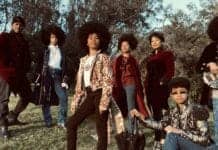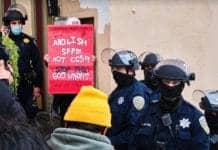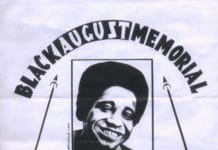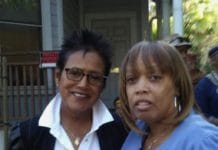Students of the Revolutionary Youth Media Education (RYME) class at Deecolonize Academy haven been learning, writing and living police terror and resistance as children of Black, Brown and poor parents. On Jan. 19, all of the youth skolaz at Deecolonize Academy and adult poverty skolaz at POOR Magazine began the day marching for MLK, for Black lives and for all of us, followed up by a trip to see the movie “Selma” and ended with a die-in on Van Ness and O’Farrell streets outside the movie theatre in San Francisco.
Martin Luther King Jr.
by Queena, 9

Last Monday I went to the MLK march. After we marched, we went to go see the movie, “Selma.” At the middle of the movie, they marched for voting rights. At the end of the movie, we did a die-in.
Civil rights did not change, because it’s still going on. The police terror did not stop, because the police are still killing Black and Brown people for standing up for their civil rights.
What I thought about “Selma” was it was nice because the people had more unity back then, but at the same time the movie was sad because my family lost relatives in real life fighting for our rights. Ava Duvernay did not get an Oscar because white Amerikkka will not reward a director for making a movie about a peaceful Black martyr that Amerikkka murdered.
After the movie, POOR Magazine and the Deecolonize youth skolaz invited the audience to join them in the die-in. Only two people out of the whole crowd participated with POOR. It gave me the feeling that not too many people cared about the rights of Black people, so the struggle continues.
We began the day marching for MLK
by Ty’Ray, 12

My mom and I drove downtown and met up with our POOR Magazine and Deecolonize Academy family. We started the march for MLK at 11 a.m. There were thousands of people; it was very powerful. After the march we drove to the Van Ness movie theatre to see the movie “Selma” about the life and work of Dr. Martin Luther King Jr.
Police terror has killed lots of Black and Brown young men then and now. The police are killing young men left and right for no reason. The fight for civil rights still exists in our neighborhoods today. Lots of young people have been shot in their own neighborhoods for gang related reasons.
The Selma director, Ava Duvernay, was not nominated for the Oscar because she is an African American and she made a powerful movie about Martin Luther King, a Black leader.
White cops and presidents
by Kimo,12
The movie “Selma” shows us that white cops and the white president, Lyndon Johnson, were not accepting Martin Luther King’s dream that he wanted Black people to be allowed to vote. Because of Martin Luther King, we are now able to vote.
After the movie, POOR magazine family made an announcement to the audience of over 300 people to join us and we marched out of the theatre to the corner of Van Ness and O’Farrell where we did a die-in. Sadly out of all the other people in the theatre only one single Black mother and her daughter joined our group of 15 people. That showed how many people cared.
The day started with a march for Martin Luther King. We walked from Townsend Street to the Metreon Theatre, and the march was about all people of color getting their rights and ending poverty.
Tiny, another mother of mine, said that this was one of the biggest marches she has ever seen, and she also said that she’s been to big ones.
The day started with a march for Martin Luther King. We walked from Townsend Street to the Metreon Theatre, and the march was about all people of color getting their rights and ending poverty.
After the march, we went to go see “Selma,” the movie. When we got into the movie theater, we saw another mom to me, Queenandi; she was in line. Then we got into the movie and I saw four girls going down the stairs. At first I didn’t know what was going on. Then I saw what happened. It scared me. The bomb was set off, and my other mom, Queenandi, said that the man who did it was a man named Dynamite Bob.
Now we found out the director of the movie didn’t get nominated for an Oscar for the great movie, maybe because the movie showed too much truth or maybe it was because it made the cops look bad. Or was it because the government is not on our side? I am thinking, and maybe I’ll find the reason.
MLK: The brave story of Selma
by Tiburcio, 11
I was surrounded by thousands of people protesting and telling and singing. It was Jan.19, 2015, in San Francisco, California, and we were marching for five blocks all around SOMA, south of Market Street, in San Francisco.

I noticed companies like Wells Fargo and United Airlines hitching on to the march, riding horse drawn carriages and giving shirts and candy to unbelievers. I believe that what Martin Luther King’s work as an activist means today is that now we have to continue what he started, as he said in 1963.
I believe that police terror now matters a lot for what MLK did then. The police murder a lot of people for no reason. They did it then too. And what MLK’s work did was tell us that we could fight back against police terror and how they inflict it.
After the march, we went to see a movie. It was called “Selma” and was about how Martin Luther King marched into Selma, Alabama, and worked with SNCC to help get voting rights in Selma. To do that, they had to march from Selma to Montgomery, Alabama.
After the movie we called for a die-in in front of the movie theater and only two people came with us. We did the die-in to commemorate MLK’s memory. I believe that the Selma fight resonates now with the Black Lives Matter Movement. Back then it was voting for the government, and now it is fighting against the government.
I believe “Selma” was not nominated for more Oscar awards because it put Martin Luther King in a good light and talked bad about police and how they inflict terror. And they think we the people, Black and Brown and even white, are getting brutalized for doing civil disobedience.
That is peaceful nonviolent protesting.
Selma – then and now
by Heidy, 15
The movie Selma by director Ava Duvernay shows the Civil Rights Movement led by Dr. Martin Luther King in the 1960s. The way he fought back against the white supremacist white people of the South is by civil disobedience. Martin Luther King was following the teachings of Mahatma Gandhi.

Even today in the 21st century we still have to deal with racism, police terror. Back then they had to deal with the murder of Black lives, and even now we still have to suffer with the death of many of Black lives. The Civil Rights Movement is an inspiration for us today. It means so much to many people because that is what led to our freedom in some way.
Police terror was a problem back then and still is now. MLK fought to stop the terror against people of color, and we can relate to that because we are also fighting to stop the killing of people of color. Black lives matter no matter what period in time, and I doubt it will stop anytime soon, so we will always fight for the equality of our people.
I think director Ava Duvernay didn’t get nominated for an Oscar because she is a woman of color. She made a very powerful film about a time that was extremely racist. The white people don’t want to bring up the past and admit that their ancestors were horrible people.
Hollywood is rooted to white supremacy, so it’s easy for them to deny an award to the people who bring up the past and their ancestors’ errors.
Read more about issues of poverty and race written by the people who face them daily at POOR Magazine/POOR News Network, www.poormagazine.org.

 Store
Store












